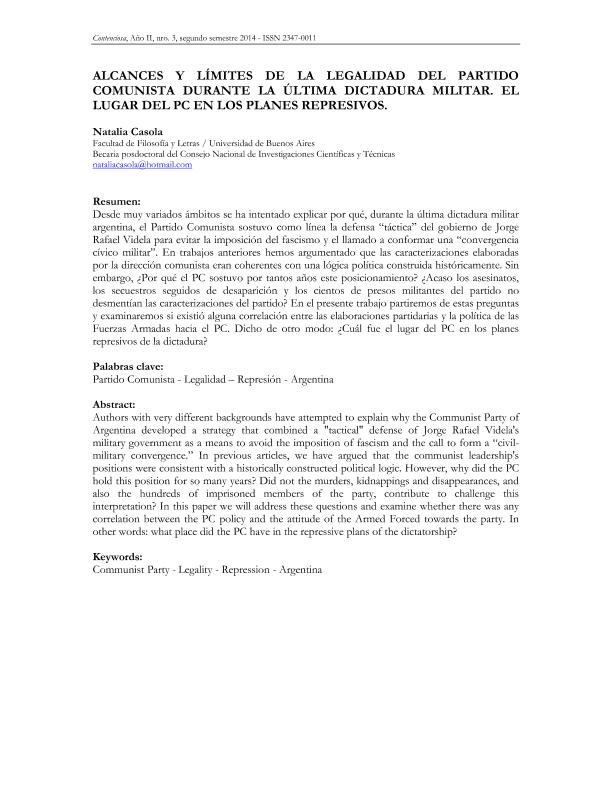Mostrar el registro sencillo del ítem
dc.contributor.author
Casola, Natalia Laura

dc.date.available
2018-07-04T19:58:12Z
dc.date.issued
2015-12
dc.identifier.citation
Casola, Natalia Laura; Alcances y límites de la legalidad del Partido Comunista durante la última dictadura militar. El lugar del PC en los planes represivos.; Centro de Estudios Sociales Interdisciplinarios del Litoral; Contenciosa; 3; 12-2015; 1-16
dc.identifier.issn
2347-0011
dc.identifier.uri
http://hdl.handle.net/11336/51251
dc.description.abstract
Desde muy variados ámbitos se ha intentado explicar por qué, durante la última dictadura militar, el PC sostuvo como línea la defensa ?táctica? del gobierno de Videla para evitar la imposición del fascismo y el llamado a conformar una ?convergencia cívico militar?. En trabajos anteriores hemos argumentado que las caracterizaciones elaboradas por la dirección comunista eran coherentes con una lógica política construida históricamente. Sin embargo, ¿Por qué el PC sostuvo por tantos años este posicionamiento? ¿Acaso los asesinatos, los secuestros seguidos de desaparición y los cientos de presos militantes del partido no desmentían las caracterizaciones del partido? En el presente trabajo partiremos de estas preguntas y examinaremos si existió alguna correlación entre las elaboraciones partidarias y la política de las Fuerzas Armadas hacia el PC. Dicho de otro modo: ¿Cuál fue el lugar del PC en los planes represivos de la dictadura?
dc.description.abstract
Authors with very different backgrounds have attempted to explain why the Communist Party of Argentina developed a strategy that combined a "tactical" defense of Jorge Rafael Videla's military government as a means to avoid the imposition of fascism and the call to form a “civilmilitary convergence.” In previous articles, we have argued that the communist leadership's positions were consistent with a historically constructed political logic. However, why did the PC hold this position for so many years? Did not the murders, kidnappings and disappearances, and also the hundreds of imprisoned members of the party, contribute to challenge this interpretation? In this paper we will address these questions and examine whether there was any correlation between the PC policy and the attitude of the Armed Forced towards the party. In other words: what place did the PC have in the repressive plans of the dictatorship?
dc.format
application/pdf
dc.language.iso
spa
dc.publisher
Centro de Estudios Sociales Interdisciplinarios del Litoral
dc.rights
info:eu-repo/semantics/openAccess
dc.rights.uri
https://creativecommons.org/licenses/by-nc-sa/2.5/ar/
dc.subject
Partido Comunista
dc.subject
Dictadura Militar
dc.subject
Legalidad
dc.subject
Represión
dc.subject.classification
Historia

dc.subject.classification
Historia y Arqueología

dc.subject.classification
HUMANIDADES

dc.title
Alcances y límites de la legalidad del Partido Comunista durante la última dictadura militar. El lugar del PC en los planes represivos.
dc.type
info:eu-repo/semantics/article
dc.type
info:ar-repo/semantics/artículo
dc.type
info:eu-repo/semantics/publishedVersion
dc.date.updated
2018-07-03T13:53:25Z
dc.journal.number
3
dc.journal.pagination
1-16
dc.journal.pais
Argentina

dc.description.fil
Fil: Casola, Natalia Laura. Consejo Nacional de Investigaciones Científicas y Técnicas; Argentina. Universidad de Buenos Aires. Facultad de Filosofía y Letras; Argentina
dc.journal.title
Contenciosa
dc.relation.alternativeid
info:eu-repo/semantics/altIdentifier/url/http://www.contenciosa.org/Sitio/VerArticulo.aspx?i=34
dc.relation.alternativeid
info:eu-repo/semantics/altIdentifier/url/http://bibliotecavirtual.unl.edu.ar/ojs/index.php/Contenciosa/article/view/5068
dc.relation.alternativeid
info:eu-repo/semantics/altIdentifier/doi/https://doi.org/10.14409/contenciosa.v0i3.5068
Archivos asociados
